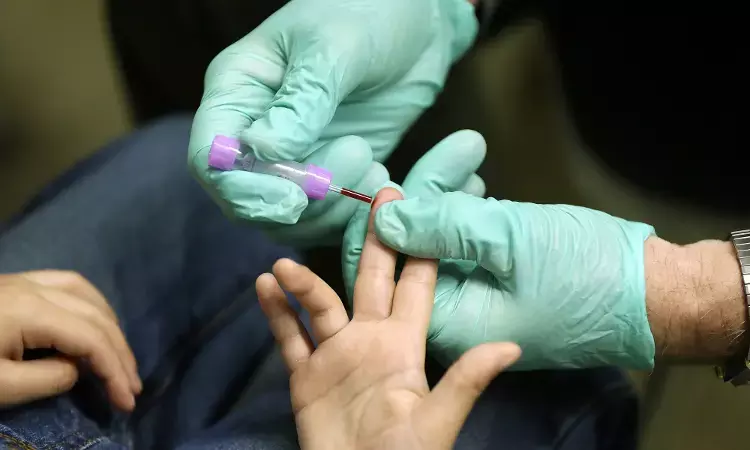- Home
- Medical news & Guidelines
- Anesthesiology
- Cardiology and CTVS
- Critical Care
- Dentistry
- Dermatology
- Diabetes and Endocrinology
- ENT
- Gastroenterology
- Medicine
- Nephrology
- Neurology
- Obstretics-Gynaecology
- Oncology
- Ophthalmology
- Orthopaedics
- Pediatrics-Neonatology
- Psychiatry
- Pulmonology
- Radiology
- Surgery
- Urology
- Laboratory Medicine
- Diet
- Nursing
- Paramedical
- Physiotherapy
- Health news
- Fact Check
- Bone Health Fact Check
- Brain Health Fact Check
- Cancer Related Fact Check
- Child Care Fact Check
- Dental and oral health fact check
- Diabetes and metabolic health fact check
- Diet and Nutrition Fact Check
- Eye and ENT Care Fact Check
- Fitness fact check
- Gut health fact check
- Heart health fact check
- Kidney health fact check
- Medical education fact check
- Men's health fact check
- Respiratory fact check
- Skin and hair care fact check
- Vaccine and Immunization fact check
- Women's health fact check
- AYUSH
- State News
- Andaman and Nicobar Islands
- Andhra Pradesh
- Arunachal Pradesh
- Assam
- Bihar
- Chandigarh
- Chattisgarh
- Dadra and Nagar Haveli
- Daman and Diu
- Delhi
- Goa
- Gujarat
- Haryana
- Himachal Pradesh
- Jammu & Kashmir
- Jharkhand
- Karnataka
- Kerala
- Ladakh
- Lakshadweep
- Madhya Pradesh
- Maharashtra
- Manipur
- Meghalaya
- Mizoram
- Nagaland
- Odisha
- Puducherry
- Punjab
- Rajasthan
- Sikkim
- Tamil Nadu
- Telangana
- Tripura
- Uttar Pradesh
- Uttrakhand
- West Bengal
- Medical Education
- Industry
Any detectable blood lead level harmful in children, finds JAMA study

Lead has no biological role in the body and no safe level of exposure to lead for children has been identified. Any detectable lead level is abnormal and potentially harmful, particularly in young children. Understanding individual and neighborhood level risk factors that are associated with any exposure to lead in children may be important in targeting efforts to mitigate adverse effects.
Hauptman et al from Boston Children's Hospital conducted a study to evaluate individual and community-level factors associated with detectable and elevated blood lead levels (BLLs) in children that may guide in implementing health policies.
In this cross-sectional study , 141 441 children younger than 6 years living in all 50 US states and the District of Columbia who underwent blood lead testing during the study period were enrolled. If the first specimen was from capillary blood and the result was 5.0 μg/dL or more, a confirmatory specimen was required within 90 days; in this case, only the results from the confirmatory specimens were considered in this analysis, consistent with the CDC definition of "confirmed elevated BLL." Children who underwent lead testing of unknown source and those with elevated BLLs who received capillary blood lead testing without confirmatory venous testing were excluded.Researchers had a special interest on pre-1950's housing because paint produced after the 1950s tended to have lower concentrations of lead than that produced earlier.
Important findings of the study are:
-Of the 1141441 children in the study, more than half of the children tested (576 092 [50.5%]) had detectable BLLs, and 21 172 children (1.9%[95%CI, 1.8%-1.9%]) had BLLs of 5.0 μg/dL or more.
-The proportion of children with detectable and elevated BLLs increased significantly for progressive pre-1950s housing and poverty quintiles (P < .001).
-Children from predominately Black populations had significantly higher proportions of children with detectable BLLs and BLLs of 5.0 μg/dL than those belonging to white population.
-The odds of detectable BLLs were significantly higher among children in the highest vs lowest quintile of pre-1950s housing and of poverty.
This large, cross-sectional, retrospective national study demonstrates that there is an association between where a child lives and the risk of any lead exposure, an important health issue with long-term outcomes at a population level.
Authors conclude-"this study demonstrates that there are still substantial individual- and community-level disparities that have important implications for addressing childhood lead exposure."
Source:JAMA pediatrics
Dr Kamal Kant Kohli-MBBS, DTCD- a chest specialist with more than 30 years of practice and a flair for writing clinical articles, Dr Kamal Kant Kohli joined Medical Dialogues as a Chief Editor of Medical News. Besides writing articles, as an editor, he proofreads and verifies all the medical content published on Medical Dialogues including those coming from journals, studies,medical conferences,guidelines etc. Email: drkohli@medicaldialogues.in. Contact no. 011-43720751


